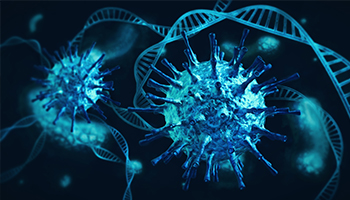HOW CAN WE HELP YOU? Call 1-800-TRY-CHOP
In This Section
Researchers Propose ‘Roadmap’ to COVID-19 Vaccine Through Cancer Immunotherapy

Oncology researchers identified regions of the coronavirus to focus on when designing a safe vaccine that imparts long-term immunity across a global population.
droseyb [at] email.chop.edu (By Barbara Drosey)
Oncology researchers usually focused on targeting neuroblastoma through immunotherapy have shifted their work toward strategizing a safe, effective vaccine against SARS-CoV-2, the virus responsible for COVID-19. If you’re scratching your head as to what oncology experts can lend to fighting the novel coronavirus, it turns out that generating an immune response against cancer faces similar challenges to eliciting an immune response against a virus.
“Cancer, in many ways, is like an infection — it is derived from within the body but behaves like a foreign invader that grows, multiplies, and metastasizes,” said John M. Maris, MD, pediatric oncologist at Children's Hospital of Philadelphia, co-leader of the Pediatric Cancer Dream Team and the Giulio D'Angio Chair in Neuroblastoma Research, and senior author of the newly published “Identification of SARS-CoV-2 Vaccine Epitopes Predicted to Induce Long-term Population-Scale Immunity.”
In the Maris Laboratory, team members develop tools to determine which unique aspects of childhood cancers can be turned into vulnerabilities that can be targeted with immunotherapies. First author Mark Yarmarkovich, PhD, a postdoctoral scientist in the Maris Lab in the Division of Oncology and Center for Childhood Cancer Research, led an approach that adapts these computational tools to the novel coronavirus, in order to identify regions of the coronavirus — called epitopes — to focus on when designing a safe and effective vaccine that imparts long-term immunity across a global population.
“We looked at unique aspects of SARS-CoV-2 that make it so infectious and deadly, including its ferocity in attaching to lung cells, to determine which unique vulnerabilities we could target with a vaccine,” Dr. Maris said.
The team identified 65 peptide sequences to prioritize for vaccine development. The results of their findings appear online on the Cell Press Coronavirus Resources Hub and will appear in Cell Reports Medicine later this month.
“We think our approach provides a roadmap for a vaccine that would be both safe and effective and could be produced at scale,” Dr. Maris said.
Strategizing a Solution
Dr. Yarmarkovich, along with colleagues John Warrington, and Alvin Farrel, PhD, used various strategies to select optimal epitopes containing protein segments common to multiple coronaviruses, as well as those that activate both B cell and T cell immune responses.
While our B cells make antibodies, it’s the T cells that help not only kill a virus, but also drive the memory necessary so that if we are re-exposed, our immune system boosts antibody production to prevent infection. Engaging T cells effectively could be the difference between a vaccine akin to the annual flu shot we are accustomed to getting, or a one-time vaccine administration. There is also potential for a combined immunization model.
“If some of the frontline vaccine approaches already in development by pharmaceutical companies are successful — which we really hope they are — it's possible this approach could make an effective vaccine even more protective,” Dr. Maris said.
In collaboration with cancer vaccinologists at the University of Pennsylvania, where Dr. Maris is Giulio D'Angio Professor of Pediatric Oncology at the Perelman School of Medicine, the Maris Lab is working with animal models to study 11 candidate vaccine constructs and assess the peptide sequences’ safety and effectiveness.
The Long View
One feature of SARS-CoV-2 in researchers’ favor is its mutation rate.
“The SARS-CoV-2 virus has a self-corrective replication mechanism that essentially checks for mistakes in the copying of the genome,” Dr. Yarmarkovich said. “It is still mutating, but is much more stable than the influenza virus, for example.”
Comparing the regions in this virus to other coronaviruses can help researchers identify the regions essential to the biology of the virus that would be more likely to appear in future coronavirus strains.
Continued preventive measures such as wearing masks and maintaining physical distance remain crucial as CHOP and Penn scientists work diligently to exploit SAR-CoV-2’s weakest points. The cancer immunologists are optimistic that sharing their depth of knowledge in complicated cancers will bring valuable insight to curtail the viral pandemic.
“We want to be prepared and do what we can to contribute to what's going to eventually get us back to normal — a safe and effective vaccine that can be scaled to the entire human population,” Dr. Maris said.
Read more about the study in the CHOP press release.